Coronaviruses are a large family of viruses that cause potentially deadly diseases in mammals and birds. In humans, the viruses spread via airborne droplets of fluid produced by infected individuals. Many Coronaviruses will appear in feces.
Some notable but rare strains, such as the Wuhan Coronavirus 2019-ncoV (now also called COVID-19 virus), and those responsible for Severe Acute Respiratory Syndrome (Sars), and Middle East Respiratory Syndrome (MERS) can cause death in humans. There are a total of seven coronaviruses that can infect humans.
First described in detail in the 1960s, the Coronavirus gets its name from crown-like spikes on its surface. Corona is Latin for “crown.”
Coronaviruses can result in a variety of symptoms in different animals. While some strains cause diarrhea in pigs and turkeys, most of the infections can be compared to a bad cold, causing mild to moderate upper respiratory problems such as a runny nose and sore throat.
There are a handful of lethal exceptions that have had a devastating impact on livestock and human health around the globe.
This new Coronavirus was first discovered in Wuhan, China, in December 2019. Researchers suspect the virus originated at a seafood market in Wuhan, where wild animals, including birds, snakes, and rabbits, are slaughtered on-site for consumption. It was first thought that snakes were the carriers but recent genetic testing suggests that bats may be the culprits. However, there were no bats sold at the seafood market, which suggests that another yet-to-be-identified animal acted as an intermediate host, allowing the virus to be transmitted to humans.
Chinese officials have quarantined 18 major cities, essentially locking down more than 56,000,000 people. As of February 13th, 2020, the latest report indicates there have been 64,658 cases reported in mainland China, and 1,488 deaths, There have been 689 cases outside of China and 3 deaths. So far, there have been no deaths in the United States from the newly-discovered Coronavirus.
The World Health Organization (WHO) has declared the new Coronavirus outbreak a public health emergency. The United States issued a level 4 (highest warning) travel advisory, warning citizens not to travel to China. Many major airlines have stopped flights to and from China, but some flights are still arriving in the US. Those passengers are being screened and in some instances, are quarantined. So far, six people in the US have been confirmed to have the new Coronavirus.
Patients with 2019-ncoV have reported mild to severe symptoms of fever, cough, and shortness of breath that began two to fourteen days after exposure. Apparently, patients with no symptoms can transmit the disease. Many patients with severe complications for the virus develop pneumonia in both lungs. As a result, some patients have died from the virus.
Health officials are still trying to better understand how 2019-ncoV (COVID-19 virus) is transmitted from human to human. Past history of other Coronavirus outbreaks suggests that respiratory droplets from coughing and sneezing are the likely methods of transmission. There is also a possibility of fecal contamination.
The CDC says the risk for the general US population is “dependent on exposure.” So unless you have been to Wuhan, China, recently, or you have taken care of someone with the virus, your chances of infection are low at the present time.
Fears have been raised about goods and mail coming from China being contaminated. Originally, it was thought that the Novel Coronavirus could only last a few hours on surfaces. Little is known about the COVID-19 virus, however, 22 recent studies of the other coronaviruses show that the viruses can survive up to nine days on surfaces. These findings should be transferrable to the COVID-19 virus.
Currently, there is no evidence to support the transmission of the new Coronavirus via imported goods, nor have there been any cases of infection in the US associated with imported goods. According to WHO, disinfecting inanimate surfaces is as easy as thoroughly cleaning environmental surfaces with soap and water and applying commonly used hospital-level disinfectants.
The same preventive measures against the flu apply to the new Coronavirus: wash your hands regularly with soap and water. If you have to be in close contact with someone who has the virus, wear an N95 respirator-type face mask and gloves. You must implicitly follow the instructions on how to properly use an N95 respirator-type face mask. Wearing the mask is not a 100 percent guarantee you will not contract the virus.
The CDC is asking anyone with symptoms and a recent travel history to China to call his or her health provider. Here is a link to the CDC website that provides information about the new Coronavirus:https://www.cdc.gov/coronavirus/index.html
Interested in additional data about the Coronavirus? See a breakdown by country, or learn more about symptoms and Incubation here.










